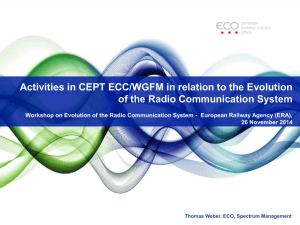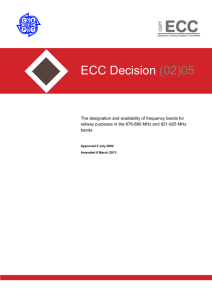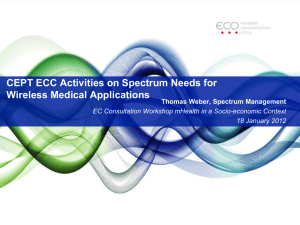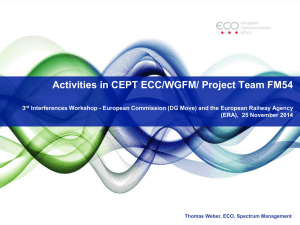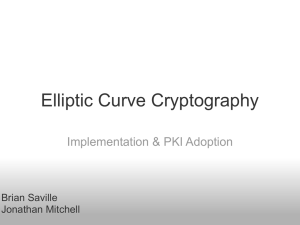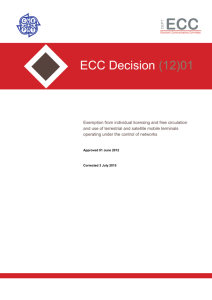ECC Decision of 27 June 2014 on withdrawal of ECC/dec/(02)07
advertisement
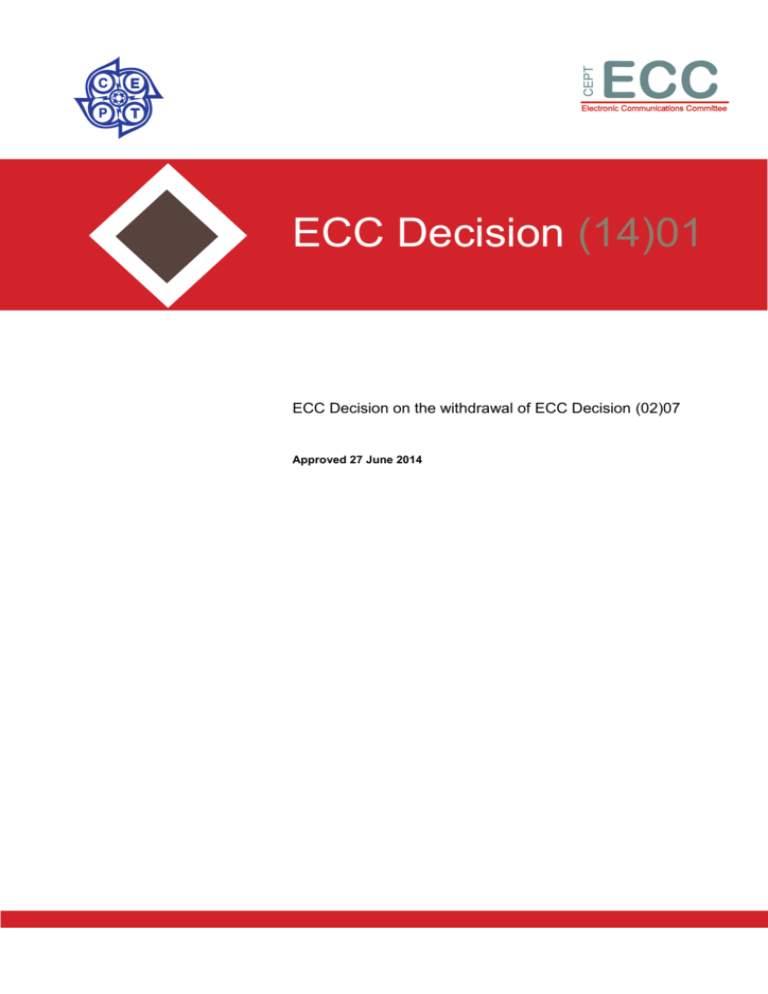
ECC Decision (14)01 ECC Decision on the withdrawal of ECC Decision (02)07 Approved 27 June 2014 ECC/DEC/(14)01 Page 2 EXPLANATORY MEMORANDUM 1 INTRODUCTION In 2013, the ECC/DEC/(02)07 of 15 November 2002 related to the harmonised European use of the bands 1670-1675 MHz and 1800-1805 MHz and on the withdrawal of the ERC/DEC/(92)01 "Decision on the frequency bands to be designated for the coordinated introduction of the Terrestrial Flight Telecommunications System" was reviewed and it was concluded that this Decision was suitable for withdrawal as it was not in line anymore with new harmonisation measures for the use of the bands 1670-1675 MHz and 1800-1805 MHz within the CEPT. 2 BACKGROUND ECC/DEC/(02)07 withdrew the ”ERC Decision on the frequency bands to be designated for the coordinated introduction of the Terrestrial Flight Telecommunications System (TFTS)” (ERC/DEC/(92)01) in 2002 after many CEPT administrations had indicated that there is no further interest in TFTS in those frequency bands. Afterwards, TFTS has been deleted from the European Common Allocation Table (ERC Report 25) and the common application terminology as set out in ECC/DEC/(01)03 Annex 2, so that there are no residuals left on TFTS in spectrum utilisation plans in Europe. On the other side, CEPT administrations have strongly promoted the retention of each of the frequency bands 1670-1675 MHz and 1800-1805 MHz for harmonised European applications to be identified. The 1670-1675 MHz spectrum is currently used by the Mobile-Satellite Service (Earth-to-space) in Europe and there is the Alphabus satellite using these frequencies. ECC/DEC/(04)09, ECC/DEC/(07)04 and ECC/DEC/(07)05 cover this frequency range and this is also shown in the European Common Allocations Table (ERC Report 25). This frequency range is also allocated to the Meteorological Aids Service and the Meteorological Satellite Service (space-to-Earth) as well as the Fixed Service and Mobile Service. For sharing of the band 1668.4-1675 MHz between the Mobile-Satellite Service and the Fixed and Mobile Services, Resolution 744 (Rev.WRC-07) applies. Usage in this band also includes passive research being conducted by some countries in a programme for the search for intentional emissions of extra-terrestrial origin. In addition, administrations are urged not to implement new systems in the Meteorological Aids Service and are encouraged to migrate existing Meteorological Aids Service operations to other bands as soon as practicable (WRC-03, footnote 5.379). The frequency band 1800-1805 MHz is allocated to the Fixed and Mobile Service. Within CEPT, this band is not planned for the harmonised introduction of IMT. Wireless audio/ multimedia applications such as wireless microphones have an assignment in the frequency range 17851804.8 MHz as included in ERC/REC 70-03 in 2013 and the technical conditions regarding the use of the band 1785-1805 MHz for wireless radio microphones were investigated and are set out in the CEPT Report 50 to the European Commission in response to the Mandate “On technical conditions regarding spectrum harmonisation options for wireless radio microphones and cordless video-cameras (PMSE equipment)”. ECC/DEC/(14)01 Page 3 3 REQUIREMENT FOR AN ECC DECISION The ECC Rules of Procedure foresee that the withdrawal of a Decision is subject to the same procedure as the development and adoption of a new Decision. ECC/DEC/(14)01 Page 4 ECC DECISION OF 27 JUNE 2014 ON WITHDRAWAL OF ECC/DEC/(02)07 “The European Conference of Postal and Telecommunications Administrations, considering a) that the existing ECC Decision ECC/DEC/(02)07 is no longer required and suitable at CEPT level; DECIDES 1. to withdraw the ECC Decision ECC/DEC/(02)07 of 15 November 2002 on the harmonised European use of the bands 1670 - 1675 MHz and 1800 - 1805 MHz and on the withdrawal of the ERC Decision (92)01 “Decision on the frequency bands to be designated for the coordinated introduction of the Terrestrial Flight Telecommunications System” 2. that this ECC Decision enters into force on 27 June 2014.”

